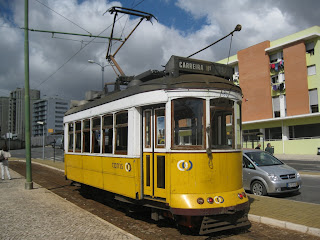 |
| Pioneer Remodelado 541 at Commercio |
In 1924 Carris - the Lisbon operator - commenced constructing its own bodies to the same style in its workshops and built 200 to the Brill design on 4 wheel trucks by 1940. Cars 203-246, 248-282 used the trucks from the 1901 crossbench cars, 415, 455, 467 & 468 on the trucks of St Louis cars and 483 was a rebody of a Brill built car.
 |
| Front and rear views - the revised light clusters being the main giveaway. Note the doors on both sides and the dual pantograph and trolley collectors |
In 1995 with a contracted system of coastal route 15 for which new cars arrived and the remaining hilly routes, Carris decided to upgrade 45 of its four wheel cars, recognising their iconic status and tourist appeal. 39 of these were taken from the 200 series (including the 415 and 483) and six from the later 700 series. All 45 were completed in 1995/6.
 |
| The cab features a modern driver's seat, Kiepe controller on the left and hand brake on the right. An air brake for parking is located just below the ticket machine. |
 |
| The rear platform has a shunt controller |
 |
| The interior shows the traditional layout with wooden panelling - though only the lower half of the windows open and fluorescent lights are now fitted behind the shades |
Body overhauls were undertaken, retaining the traditional appearance but the cars became single ended, though doors are retained on both sides, albeit with the offside ones not used. Ferrostaal provided new trucks with 2x 50 kw Skoda motors allowing a top speed of 50km/h (31mph) and Kiepe controllers. With 17 power and 15 brake notches the new controllers give a much smoother acceleration and braking than the old DB1s. The brakes are a mix of air and electric with air track brakes and air parking brakes to cope with the challenging hills. The cars were numbered 541-585 with the 579, 581-585 being the six former 700 series cars. The bodies, dating from 1932 to 1937 were fitted onto new underframes and being constructed from wood do suffer from the significant stresses placed on them by the equipment and terrain. Fortunately Carris have a skilled bodyshop and keep overhauling the bodies with 541-544 showing evidence of recent works attention.
 |
| 582 is one of the shabbier cars - note the rotten pillar by the doors |
 |
| 552 demonstrates the application of advertising - which is now by no means universal compared to a few years ago |
 |
| Tourist car 7 (ex 584 and originally 707) shows the change from trolley to pantograph at Estrela |
Today all 45 remain in use, though six have become tourist cars 5-9 and 11 (ex 585, 585, 546, 584, 570 and 569 resp). These are used on the "Colinas" Hills Tram Tour in a red livery, whereas the remainder are in yellow and white, several with side and end adverts. All feature both trolleys and pantographs. Trolleys are required on route 12 and 28 but the cars use pantographs on the 15, 18 and 25. Unusually the tourist route changes collector twice (at Praça da Figueira to a trolley and at Estrela) to a pantograph to comply with the trolley requirement on route 28.
During a visit in early October, 39 of the 45 cars were noticed in service 541-545, 548, 550-558, 560/1, 563-568, 571-576, 578, 580-582 and Tourist cars 5-9 and 11. Cars 559, 562 and 577 were observed in the depot but not in service while 547, 549 and 579 were not noted, though one unidentified car was stripped down in the works.
These trams are an excellent compromise between a desire to retain the traditional trams and a need to modernise their equipment. At just 20 seats, but 38 standing, they can be slow loading and heavily loaded but their equipment is well suited to the routes, with appropriate acceleration and braking, doing away with the need to use handbrakes to help descend the hills.

